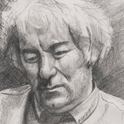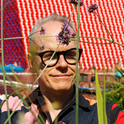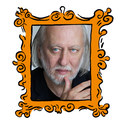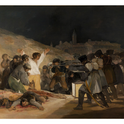“I tried each thing, only some were immortal and free.” These words, which begin John Ashbery’s most celebrated volume, Self-Portrait in a Convex Mirror (1975), were extensively quoted on social media when the poet died last autumn at the age of 90. It was not an untimely death, but the news still felt like a shiver in the natural order. Regularly described as “America’s greatest living poet,” Ashbery himself seemed to be one of the immortal things, who would defy death with his infinite jest. “Time, you old miscreant!” began a poem published when he was 75, “Slain any brontosauruses lately?”
For all the rakish insouciance of such lines, the deep appeal of Ashbery’s voice was always its I-have-foresuffered-all sagacity. “We see us as we truly behave,” begins his first book, Some Trees (1956), establishing the 29-year-old poet’s bardic willingness to speak for the one and many, like Walt Whitman before him. Venturing further, the reader encounters inexplicably gnomic images, haunted by meaning, such as “In a far recess of summer / Monks are playing soccer.”
The volume was published with an introduction by Ashbery’s poetic hero, WH Auden, who acknowledged its strangeness with the observation: “From Rimbaud down to Mr Ashbery, an important school of modern poets has been concerned with the discovery that, in childhood largely, in dreams and daydreams entirely, the imaginative life of the human individual stubbornly continues to live by the old magical notions.” Auden was, in effect, presenting Ashbery as a young surrealist. But he was also noting that there is a sympathy in these poems with the everyday magical thinking that creates meaning in our lives.
Karin Rofmann’s The Songs We Know Best: John Ashbery’s Early Life is the first biography of the poet. Written with Ashbery’s support, it gives a fascinatingly detailed account of a childhood that was shadowed by loneliness and melancholy.
Born in Rochester, New York in 1927, Ashbery grew up on his parents’ fruit farm in Sodus, near Lake Ontario. He was never happy near his father, however, who had a violent temper, and preferred city life at his maternal grandparents’ house in Rochester, where his imagination fed on their Victorian bric-a-brac and illustrated children’s encyclopedia, The Book of Knowledge. (In 1941, he briefly became a local celebrity after appearing on the national radio show, Quiz Kids.)
His first poem, written at the age of eight, was inspired by Max Reinhardt’s sparkly film of A Midsummer Night’s Dream (1935). “The Battle” imagines a winter skirmish between a tribe of fairies and the bushes that surround them. As the poem elaborates on this curious conceit, its doggerel couplets begin to sound remarkably Ashberian in their explanatory oddness:
They celebrated their victory with a feast,
With turkey and dressing and cakes of yeast.
But let us get back to the trees and the bushes.
They are weighted down with snow that pushes and pushes.
Ashbery’s mature poems would be fascinated by “the trees and the bushes”: the mundane dioramas that surround the action of our lives.
Ashbery’s book-length sequence Three Poems (1972) pays tribute to the stream-of-consciousness sentence-curling of the modern prose stylists he most admired: Marcel Proust, Gertrude Stein and Henry James. It opens with a characteristically diffident statement of intent:
I thought that if I could put it all down, that would be one way. And next the thought came to me that to leave all out would be another, and truer, way.
clean-washed sea
The flowers were.
These are examples of leaving out. But, forget as we will, something soon comes to stand in their place. Not the truth, perhaps, but—yourself. The isolated phrases parody the Imagism of Ezra Pound, who asserted that modern poetry was to be founded on the mental photography of a few intensely right words. But, for Ashbery, striving after such a purified version of poetic knowledge was a mistake; there was no ultimate “truth,” only experience (“—yourself”).
This disarmingly simple philosophy made Ashbery the poetic embodiment of postmodernism. He always maintained that the significance of TS Eliot’s modernist masterpiece The Waste Land (1922) was as “a collage of hallucinatory, random fragments.” Ashbery’s second book, The Tennis Court Oath (1962), was his most challenging experiment with Dada-esque cut-up techniques, comprising verse that sometimes seems to be pinned together by nothing more than its own abrupt and vivid discontinuity (“And the murderer’s ash tray more easily— / The lake a lilac cube”).
The Tennis Court Oath was written largely while living in France, where Ashbery—who studied English literature at Harvard and Columbia—had gone as a Fulbright Fellow in 1955, returning in 1958 to begin doctoral research on the avant-garde writer Raymond Roussel. The PhD was never finished, but Ashbery continued to live in Paris with his lover, the poet Pierre Martory.
It was during his decade abroad, ironically, that the label “New York School” was first applied to the poets with whom he was most often associated, such as Frank O’Hara, Kenneth Koch and Barbara Guest. Ashbery left France to live permanently in New York in 1966, earning money by writing art criticism, a genre in which his sharp wit often flashed its blade (“Only God can make a tree, but lots of people can turn out pseudo-Henry Moore monuments”). Among Ashbery’s most self-revealing pieces of criticism is the 1989 essay “Poetical Space,” which remarks of the depthless skies in the work of the surrealist poet and painter Giorgio de Chirico: “How satisfying to feel that one lives in these flattened spaces.”
At Harvard, Ashbery had himself experimented with producing his own “flattened spaces” in the form of surrealist collages. He returned to the practice during his last decade, making the work that has been gathered in a posthumous book, published in March, They Knew What They Wanted: Collages and Poems. Ashbery’s collages typically juxtapose figures and landscapes scissored from magazines or postcards: a young, silk-gowned woman lecturing a parrot in a lightning storm; the comedian Jerry Lewis gurning in front of a sea-cliff and the rose-window of Chartres; boardgames sprinkled with Old Master paintings and cigarette cards.
Ashbery’s collages pay homage to an artist he strongly admired, Joseph Cornell, and his delicately balanced boxes of junk-shop fragments. But their sillier juxtapositions also owe something to the cartoon humour of Pop Art, an influence which began to make itself felt in his poetry from 1970’s The Double Dream of Spring onwards. The poem “Farm Implements and Rutabagas in a Landscape,” for example, places characters from the Popeye cartoon inside a sestina, a highly patterned poetic form that repeats six end-words in different combinations (one of the end-words is “spinach”).
Such humour, and its subversion of the macho norm embodied by Popeye’s ballooning biceps, might once have been called camp. Now, literary criticism would call it queer. Growing up in mid-century America, Ashbery felt guiltily “afflicted” by his homosexuality, and throughout his life his writing remained enigmatic about his biography. But as the poet Eileen Myles comments, he is a gay poet who both “makes light of it, and [knows] that it is pretty much everything.”
The melancholy poem “Friends,” from Houseboat Days (1977), for example, acquires a sharper poignancy when it is decoded as a gay poem that speaks whimsically for serious reasons:
The banker lays his hand on mine.
His face is as clean as a white handkerchief.
We talk nonsense as usual. The Prufrockian imagery of socially repressed emotion (“The banker lays his hand on mine”) leads the reader back to the nursery-rhyme “nonsense” of the poem’s first line, with its deniable glance at gay slang (“I saw a cottage in the sky”). It also charges the penultimate lines with anxious implication (“I bite my lip and / Turn to you. Maybe now you understand”), and, of course, illuminates the quiet euphemism of the poem’s title.
Like the reflected hand of the painter in the title-poem of Self-Portrait in a Convex Mirror, Ashbery’s writing often seems to be both “thrust at the viewer / And swerving easily away, as though to protect / What it advertises.” The prolonged curve of thought which both includes and excludes is Ashbery’s signature gesture as a poet. Dip in to his writing anywhere and you will soon find yourself being carried along by an elegantly braided sentence seeking a full stop far from its starting point. The aim is not, however, obscurity, but a new and beautiful arrangement of words, never before seen on paper. As he wrote in his undergraduate thesis on Auden: “every new poem is a fresh discovery.”
***
John Ashbery’s last ever published poem was nearly one that includes the line: “Our legends always come around to seeming legendary.” Titled “The Vegetarians,” it appeared at the end of Shadow Train (1981). The following year Ashbery was hospitalised with a spinal epidural abscess that nearly killed him. He survived, however, and went on to enjoy a now legendary old age. As he approached his 60th birthday in the summer of 1987, mourning his mother, who died that year, Ashbery set himself to write a 100-page poem diary-style, tapping out one page a day on his typewriter. This would become his longest work, Flow Chart (1991), an epic meditation on the American sense of destiny (the final image is of “the bridge, that way”), which is also an obliquely autobiographical masterpiece of free association (the manuscript shows that many lines are printed as typed, without revision).
Flow Chart’s use of an extremely long verse line makes it the most Whitmanesque of all Ashbery’s surveys of his interior landscape, democratically letting in everything that both enters and leaves his mind (“Excuse me while I fart. There, that’s better. I actually feel relieved.”) It is now included in Collected Poems 1991–2000, the second volume published by the Library of America in the US and Carcanet in the UK.
The baker’s dozen of new collections that came after Flow Chart—which ended with his last book, Commotion of the Birds (2016)—are broadly what is covered by the critical category “late Ashbery.” Reviewers wrestled with increasing desperation to find something new to say about this vast body of work, which seemed determined to expand the oeuvre indefinitely with hundreds of dreamily ruminative, drily humorous poetic off-cuts (often the reviewer’s general conclusion was that “intimations of mortality” could be detected).
Yet it was rarely said that an individual Ashbery poem was “bad”—perhaps because he had so triumphantly challenged the idea that poetry was a business of po-faced editorial finicking and polish. There are always good things to find in a late Ashbery book, but not always whole poems. The elder Ashbery’s relish for uniquely bizarre word combinations (“fish vulgate,” “landfill clamor”) also makes him an excellent source of online passwords.
Ever since an early bout of writer’s block was broken by hearing John Cage perform his piano score, Music of Changes (1951), which was inspired by the I Ching, Ashbery regarded inspiration as a matter of “managed chance.” A 2005 New Yorker profile by Larissa MacFarquhar described in fly-on-the-wall detail how the elderly poet pottered around his Chelsea apartment, waiting for something to spark a poem. When he was finished writing a piece, he said, “a kind of timer” went off, telling him to “remove it from the oven.”
This casual attitude towards his vocation bemused those who cherished a conception of the poet as a public figure whose moral authority derives from formal mastery. Seamus Heaney, for example, felt Ashbery offered readers a “centrally-heated daydream,” which knew it was “inadequate” to American political reality. By implication, his apparent difficulties were artful distractions from the fact that he had nothing to say. But the poet himself hoped otherwise: “maybe people will, by the nature of my non-political poetry, become more people. I mean a person will become more of a person.”
This emphasis on the humanising quality of poetry is telling. Ashbery’s postmodernism never sounds like the confessions of a computer. The critic Helen Vendler once observed that Ashbery’s “gift for American plainness is his strongest weapon”—and his plainer lines could easily be mistaken for everybody’s favourite farmer-poet, Robert Frost. One of my own touchstones is a short love lyric, “Just Walking Around,” from A Wave (1984), which Ashbery recorded in 2003 for the Poetry Archive in London. His soft, flat, nasal voice modulates the halting music of the poem’s final stanza perfectly:
The segments of the trip swing open like an orange.
There is light in there, and mystery and food.
Come see it. Come not for me but it.
But if I am still there, grant that we may see each other.
In its generosity, comedy and simplicity, this has what the poet Frank O’Hara once called his friend’s “nuptial quality”—a tone of voice that always seems to be murmuring “dearly beloved” in front of a congregation.
One little-known fact of Ashbery’s biography is that he was a church-goer, who belonged to an Episcopalian congregation—and indeed the language of Christianity is as much a part of his all-American diction as the language of cartoons. His last poem, written just a week before his death last year, ends: “Not exactly evil, but you get the point.”
The imaginary voice that, to my mind, makes the most sense of Ashbery’s demanding but forgiving poetry speaks wearily but clearly here: the mild-mannered, far-seeing, quizzical priest.













